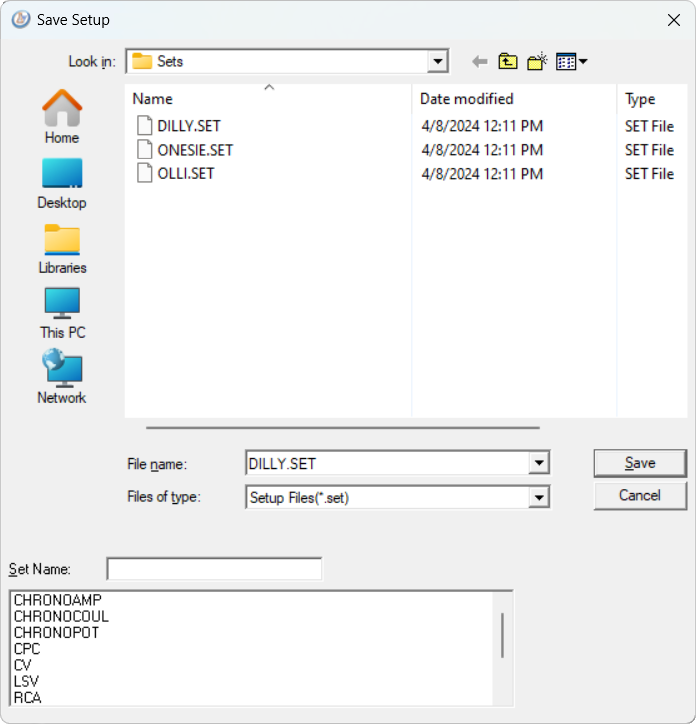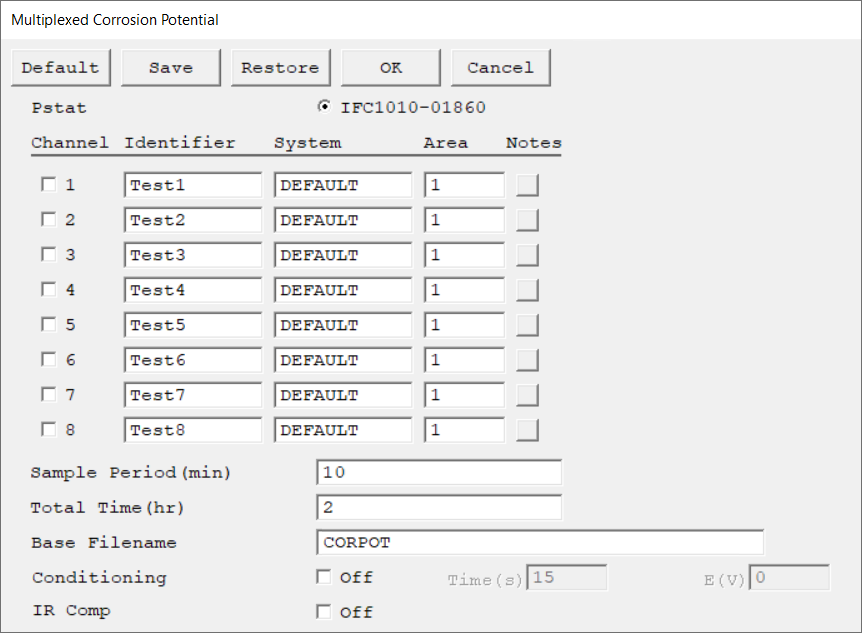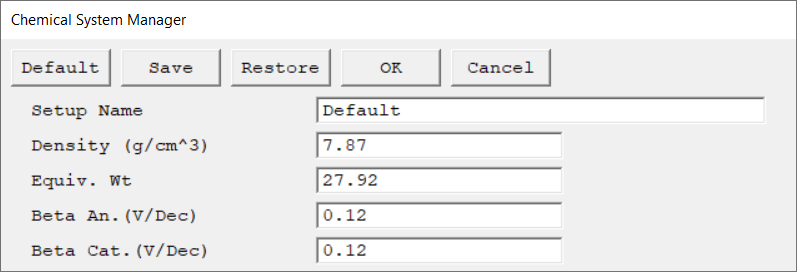Description
Save the current parameter set to an auxiliary database on your computer.
Instead of entering setup parameters individually, use a pre-defined set of parameters with a specific Set Name. This is a keyword to define a set of system parameters, stored in a setup file with the file extension *.SET. More than one parameter set can be stored in each file, with each set distinguished by a Set Name.
This feature is especially useful when running repetitive tests and it is a powerful tool for organizing experimental setups. For example, different people in a lab can have their own setup files ("DILLY.SET", "ONESIE.SET", "OLLI.SET", etc.). Within the file, Dilly can save multiple parameter sets under descriptive Set Names ("CPC", "CV", "LSV", etc.).
Framework's Setup Save/Restore mechanism is used to save and recall parameter sets from the file. After entering your setup parameters in the setup window, click the Save button to open the Save Setup dialog box. Choose the setup file where you wish to save the parameter set and the Set Name within the file. Press Save to confirm.

Save Setup dialog box.
Make sure to specify a Set Name when saving a setup file. |
Setup files are written in ASCII format, divided into sections which are identified by the Set Name. Below is an example of a small parameter database file containing two sets.
[INDEX]
DEFAULT=
SAMPLE 1=
[DEFAULT]
DENSITY=6
EQUIV=58
BETAA=0.12
BETAC=0.12
[SAMPLE 1]
DENSITY=6.8
EQUIV=39
BETAA=0.105
BETAC=0.155
Each file begins with the [INDEX] section which contains a list of each Set Name within the file. Following the [INDEX] section are the individual electrochemical parameter sets. Each section starts with the Set Name enclosed in square brackets, here [DEFAULT] and [SAMPLE 1]. Below the set name is the setup parameter and its designated value.
Spaces are allowed in the Set Name. The Save/Recall process is case-independent, so default, Default, and DEFAULT all refer to the same setup. Other than this sole exception, you must exactly match a section name in the database file to successfully extract a parameter set from the file. |
System Database for Multiplexed Experiments
Multiplexed experiments have a special setup parameter called System which can be set for each channel individually. This parameter is linked to a setup file called SYSTEM.SET and contains values for material densities, equivalent weights, and electrode kinetic parameters. Instead of entering these values individually for each channel, you only enter a Set Name of said SYSTEM.SET file.
Gamry provides a special script, SYSTEM.exp, whose job is to add new entries to the SYSTEM.SET database file. Run this script using the Framework™ Experiment > Named Script... command. The Chemical System Manager dialog box opens.
This database entry Setup window works somewhat differently than typical Setup windows. The Default, Save, and Restore controls are not used. Press Cancel to exit the script.
When you click the OK button, the parameter set in the dialog box is stored in the SYSTEM.SET database file. The name of the saved system is given by the Setup Name parameter.
We recommend using a descriptive Setup Name. This will help you when it is time to use the parameter set. |
When you save the parameter set, a Query window opens. In this box, you can choose to create another database entry by clicking the Yes button. Or, you can click the No button to terminate the script and return to the Framework Experiment Control program. Regardless of your answer to the Query, the previous parameter set is already stored.
Related Topics


